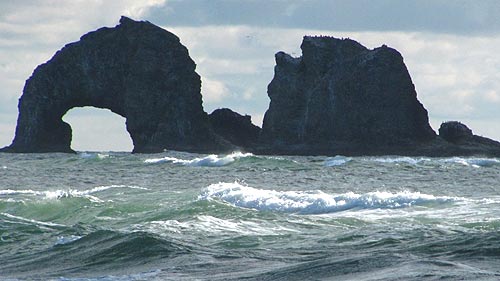 |
Remnants of Doomsday Monster Seen All Around Oregon Coast
Published 09/02/2012

(Oregon Coast) – Anything alive in the proto-Oregon territory experienced doomsday back about 15 million years ago, and that time may come again in the future of western civilization. However, that end-of-the-world scenario back then meant new life for what would become the Oregon coast. Massive lava flows, sometimes 20 feet and stretching 300 miles long once scorched this area in that period, ironically giving rise to much of the diverse beauty we now enjoy in this tourism hotspot in the Northwest United States. (Above: Cape Meares)
Most of the major landmarks seen around this coastline come from that fiery period – and interestingly enough it's all related to a super volcano lurking in Wyoming that could well mean an extinction-level event on planet Earth someday.

Cape Lookout
Look all around these beaches and you get an idea of its overwhelming power. Places like Cape Foulweather, Cape Lookout, Yaquina Head and Cape Meares were formed from these massive flows. While other major landmarks - like Tillamook Head, Neahkahnie Mountain near Manzanita or Cannon Beach's famed Haystack Rock – were strange secondary eruptions that happened because of the initial massive ones.
Starting around 15 million years ago, a colossal fissure in the Earth around where Lewiston, Idaho is now poured these insanely huge flows into this area. It’s the same hot spot that now powers Yellowstone National Park, and has before created the mega-disastrous super volcanoes that have erupted a few times over the ages.
 |
| Haystack Rock, Cannon Beach |
These flows shot out over a few hundred miles, over to what is now the Oregon coast. Numerous such eruptions happened over millions of years, and scientists don't really know how many. These are called the Columbia River Basalts, as they also formed the Columbia Gorge along the way.
Cape Foulweather, Cape Lookout, Yaquina Head and Cape Meares were the result of these flows filling up huge canyons that existed at the time. Eventually, these spots rose and fell over the 15 million years, several times over, and the canyon stuff around the cooled basalt eroded away, leaving just the black rock – a bit like a molding cast. Eventually, erosion took its toll on these areas as well, especially by the sea, whittling them into the shapes we know and love as the towering cliffs and headlands that attract tourists and whale watchers.

Neahkahnie Mountain and Tillamook were something a little different and more surprising. These eruptions were so powerful they would burrow down into softer sediment and then come back – re-erupting elsewhere. They are called intrusive basalts, because they intruded down into the Earth's sediments and softer material and re-erupted.
This kind of eruption created a lot of the smaller rock structures we know, such as the famous Haystack Rock at Cannon Beach, the other Haystack Rock at Pacific City and Twin Rocks at Rockaway Beach.
Other major landmarks have their own separate story. According to Seaside-area geologist Tom Horning, Cascade Head – near Lincoln City – was its own volcano. So was Cape Perpetua near Yachats.
During the Columbia Basalt flows, that fissure at Yellowstone was farther west because plate tectonic movement over the epochs moved it eastward to where it is now. The Oregon coast was something like 15 miles farther inland around 17 million years ago when these eruptions began.

Cascade Head near Lincoln City: this was once a volcano
So, it seems, we can thank that massive hole in the Earth – at least for now. But scientists say that big fissure at Yellowstone is just itching to become a super volcano again. According to one estimation, by Wyoming geophysicist Bob Smith in his book “Windows into the Earth,” its initial blast has the potential to kill hundreds of thousands of people instantly. The resulting gas and dust cloud from such an eruption would likely squash the food chain on the entire planet.
The last such eruptions in Yellowstone have happened about 800,000 years apart, Smith told CNN.com recently. The last one was 640,000 years ago.
Scientists, headed up by Smith, are keeping a watch on that area.
Keywords: geology, history, cape kiwanda, Oregon coast, super volcano, science, Cannon Beach, Pacific City, Yachats, Depoe Bay, Newport, Lincoln City, Oceanside, Astoria.
More About Oregon Coast hotels, lodging.....
More About Oregon Coast Restaurants, Dining.....
 |
 |
LATEST OREGON COAST NEWS STORIES
CME Heads for Earth, Possible Aurora Borealis Monday Night for Oregon, Washin... |
Back to Oregon Coast
Contact Advertise on BeachConnection.net
All Content, unless otherwise attributed, copyright BeachConnection.net Unauthorized use or publication is not permitted
Secrets of the Season |
Unusual Travel Articles TravelParanormal.com allows you to submit your own creepy tale or debunk one - or see up-to-the-minute news headlines about travel and the paranormal. News Headlines from All Over Oregon Need to scan Oregon headlines? Constantly updated news from all over Oregon: a comprehensive, up-to-the-minute display of news headlines from a variety of media |






































